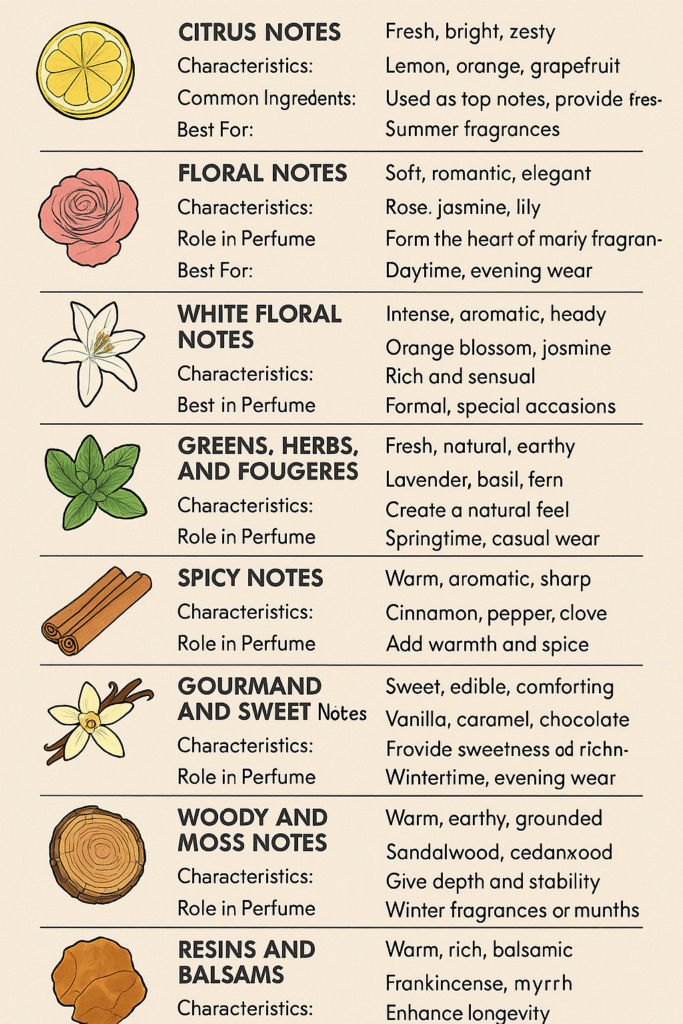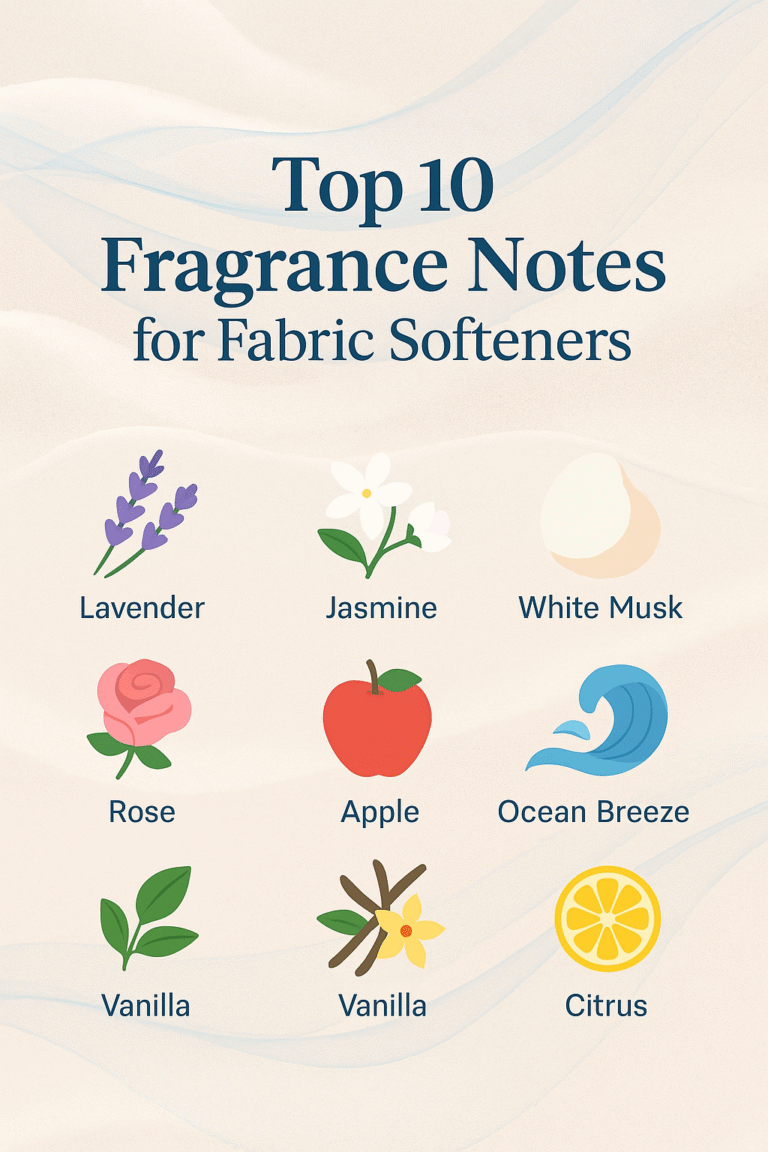Guía completa de notas de perfume y sus funciones: Una inmersión profunda en los cítricos, florales, amaderados y más
🌸 Perfume Notes and Their Classification: A Comprehensive Guide to Fragrance Families
Perfume is an intricate art of blending various aromatic ingredients to create a sensory experience. The key to a great fragrance lies in understanding its notes. A note refers to the different layers of scent that emerge over time as the perfume settles on your skin. These notes are classified into families based on their aroma characteristics. Understanding these classifications helps both perfume lovers and manufacturers alike in selecting and blending scents for unique fragrance experiences.
1. Introduction to fragrance Notes
In the world of perfumery, fragrance notes are categorized into three main layers: top notes, middle notesy base notes. Each note serves a specific purpose in how a perfume is perceived, from the moment it’s applied to when it lingers on the skin.
- Top Notes: These are the first impressions of a fragrance, providing a fresh and often light scent that evaporates quickly.
- Middle Notes: Also known as the “heart” of the perfume, they emerge after the top notes dissipate, contributing to the main body of the fragrance.
- Base Notes: The foundation of a perfume, base notes are the heaviest and most enduring, leaving the fragrance lasting on the skin for hours.
2. fragrance Notes: Family Classification Overview
Perfume notes are grouped into families that share similar olfactory characteristics. These families create the foundation of fragrance design and influence the overall appeal of the perfume. Let’s dive deeper into each of the major families:
3. Perfume Note Families
Citrus Notes
- Characteristics: Citrus notes are known for their fresh, bright, and zesty scent profile. They are highly volatile and are often perceived as invigorating and energizing.
- Common Ingredients: Lemon, orange, bergamot, grapefruit.
- Role in Perfume: Typically used as top notes, citrus notes provide a fresh opening that immediately captivates the senses.
- Best For: Summer fragrances or morning wear, as they offer a refreshing and clean sensation.
Fruits, Vegetables, and Nuts
- Characteristics: Fruit, vegetable, and nut-based notes offer a diverse range of smells, from sweet and juicy to earthy and nutty. These notes can provide a fresh, natural feel or a warm, comforting depth.
- Common Ingredients: Peach, plum, almond, fig.
- Role in Perfume: These notes are often used in the middle to base notes to create complexity and fullness in a fragrance.
- Best For: Autumn and winter fragrances, as they add warmth and depth.
Floral Notes
- Characteristics: Floral notes are the most widely used and are often associated with elegance, femininity, and romance. They range from soft, powdery florals to heady, opulent blooms.
- Common Ingredients: Rose, jasmine, lily, violet.
- Role in Perfume: Floral notes are typically used as middle notes, creating the heart of the fragrance. They provide richness and emotional depth.
- Best For: Daytime and evening wear, particularly for romantic or formal occasions.
White Floral Notes
- Characteristics: White florals tend to be more intense and aromatic than regular floral notes, offering a strong, sweet, and often intoxicating fragrance.
- Common Ingredients: Jasmine, orange blossom, gardenia.
- Role in Perfume: These notes are rich and heady, often used to add sensuality and luxury to perfumes. They are also used as middle or base notes.
- Best For: Formal events, evening wear, and special occasions where an intense floral scent is desired.
Greens, Herbs, and Fougeres
- Characteristics: This category of notes is known for its fresh, natural, and earthy qualities. These notes often evoke the scent of fresh-cut grass, herbs, and leafy greens.
- Common Ingredients: Lavender, basil, fern, tomato leaf.
- Role in Perfume: These notes create a refreshing, outdoor feel and are typically used in the heart or middle notes of a fragrance.
- Best For: Springtime and casual daytime wear, giving a natural and calming impression.
Spicy Notes
- Characteristics: Spicy notes are warm, aromatic, and often sharp, adding complexity and a touch of heat to a fragrance.
- Common Ingredients: Cinnamon, pepper, cardamom, cloves.
- Role in Perfume: These notes are used in the middle and base notes to provide depth and warmth.
- Best For: Autumn and winter fragrances, adding a cozy and inviting feel.
Gourmand and Sweet Notes
- Characteristics: Gourmand notes are sweet, edible, and often dessert-like. These notes can evoke the scent of candy, chocolate, or other sweet treats, making them incredibly comforting and delicious.
- Common Ingredients: Vanilla, caramel, chocolate, coffee.
- Role in Perfume: These notes are primarily used as base notes, providing sweetness and richness that lasts long after the top notes have evaporated.
- Best For: Wintertime and evening wear, particularly for people who enjoy sweet and comforting fragrances.
Woody and Moss Notes
- Characteristics: Woody notes are warm, earthy, and grounded, often associated with the smell of trees, forests, and nature. These notes provide depth and a sense of stability to a fragrance.
- Common Ingredients: Sandalwood, cedarwood, oakmoss, vetiver.
- Role in Perfume: Used in the base notes, woody notes serve as the foundation of many perfumes, giving them a solid, enduring base.
- Best For: Evening wear or colder months, providing a deep, sophisticated scent.
Resins and Balsams
- Characteristics: These notes are warm, rich, and often sweet, reminiscent of tree sap or resins. They add a deep, balsamic quality to perfumes.
- Common Ingredients: Frankincense, myrrh, benzoin.
- Role in Perfume: Resins and balsams are used as base notes and help fix the fragrance, enhancing its longevity.
- Best For: Winter fragrances or evening wear, where warmth and complexity are desired.
Musk, Amber, and Animalic Notes
- Characteristics: Musk and amber are warm, sensual, and often exotic. These notes can evoke a feeling of intimacy and depth, making them some of the most sought-after base notes.
- Common Ingredients: Musk, amber, civet, castoreum.
- Role in Perfume: These notes are often used in the base to provide depth, warmth, and lasting power to a fragrance.
- Best For: Evening wear or special occasions, particularly in perfumes meant to evoke sensuality.
Beverage Notes
- Characteristics: Beverage notes are based on the scents of various drinks, adding a fresh and fun twist to fragrances.
- Common Ingredients: Champagne, coffee, tea, cola.
- Role in Perfume: These notes are used to create a refreshing and playful element, often adding lightness and sweetness.
- Best For: Casual daytime wear or summer fragrances.
Natural vs. Synthetic Notes
- Characteristics: Some notes are derived from natural sources, while others are synthetically created. Natural notes come from flowers, fruits, and woods, while synthetics can mimic rare ingredients or create entirely new scents.
- Common Ingredients: Natural (rose, jasmine), Synthetic (Iso E Super, Hedione).
- Role in Perfume: Both natural and synthetic notes are used to enhance fragrance composition. Synthetics allow for more stability and creativity, while naturals offer authenticity and depth.
4. Conclusion: The Diversity and Importance of Perfume Notes
The world of perfume notes is as vast and varied as the fragrances they compose. From the light zest of citrus to the deep warmth of amber, each note has a unique role in creating a balanced and captivating scent profile. Understanding these different fragrance families is key to crafting personalized perfumes that resonate with the individual preferences of consumers.
As the fragrance industry continues to evolve, the creativity and innovation within these families also expand. Perfume makers now have the flexibility to combine traditional notes with synthetic, experimental ingredients to create new and exciting fragrances for the modern market.
5. References
- Fragrantica – The ultimate fragrance encyclopedia for perfume enthusiasts.
- Perfume Design and Composition Techniques – Perfume creation resources from industry experts.

